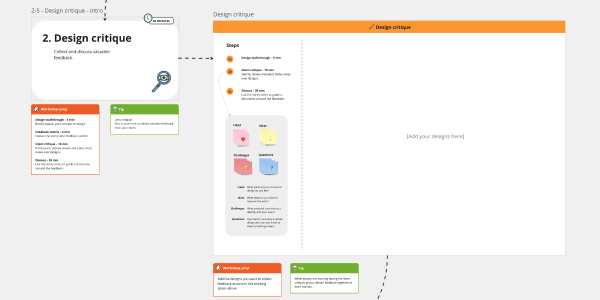Most plays in this playbook involve minimal preparation. With the design critique, there is a small amount of preparation required to save time during the session and to keep things focused.
Preparation time will depend on the complexity and number of designs that need to be critiqued.
Prepare the designs
With the focus of the play being a design critique, it’s important to have the designs ready for critique in Miro or Microsoft Whiteboard if you’re running the workshop remotely. There are a few ways to share your designs in Miro – you can embed PDF’s, attach images, or even use a Figma plugin to link directly from a Figma board.
If you are facilitating the design critique in person, you can use the projector or screen to talk through the designs. You could also print smaller versions of the designs for people to place on their sticky notes with feedback.
Invite your participants
Participants in this session should be made up of the project team and any subject matter experts relevant to the project. This might include a Project Manager (PM), Project Officer, Designer, Business Analyst, Communications Officer, Solution Architect, or Developer. Aim for including a range of people to form a multi-disciplinary team. You’ll want to make sure when you send an invite for the session, that you clearly explain the goal, how long it’ll take, and why people’s participation will be beneficial.
It’s important to give enough notice to ensure participants have free time to come along to the session. Aim to send invitations about 2 weeks in advance.
You can also attach the play for people to look at ahead of time.
Calendar invite for design critique
Subject:
Join us for a design critique session for [project name]
Meeting description:
Hi [team name if sending a group invitation, or participant name if sending individual invitations]
We're in the early stages of design development for our [name of project] work and would love to have you give some feedback. In this session we will be reviewing early designs and concepts, and providing critique to direct further development.
The session will take about [x] minutes and there is no preparation required.
Having [you/each of you] attend will ensure the work is reviewed from various perspectives and help us to avoid missing any crucial considerations. We will be using Miro for this workshop, and you can read more about the design critique session in the Digital service design playbook.
I look forward to your contribution to the session. [If you’re planning to record the session include the following - We will be recording the session for learning and development purposes and record keeping. Please let us know before the session if you don't want to be included in the recording or transcript].
Kind Regards,
[facilitator name]




